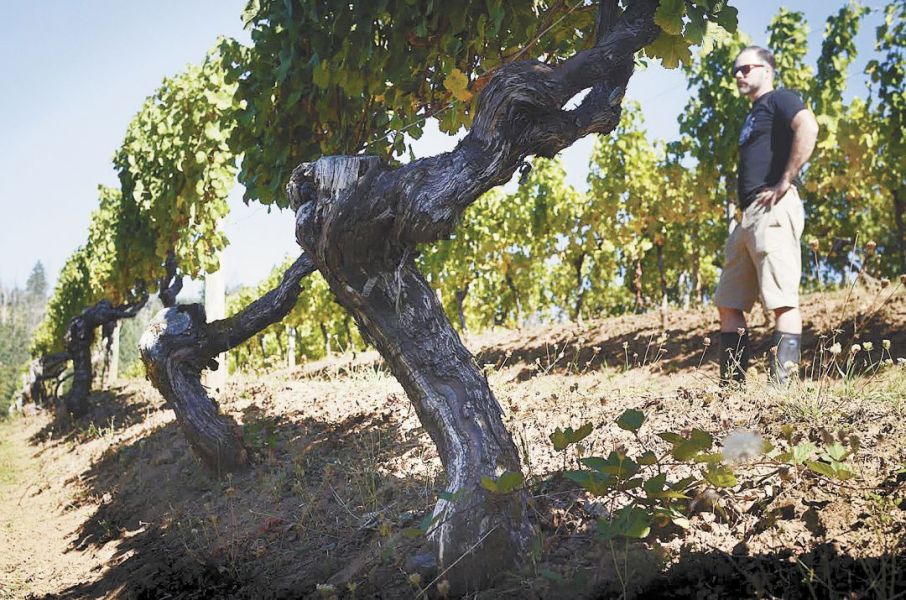The Changeup: Golden Opportunity
Jeff Vejr sources Flora from historic vineyard
David Hill Vineyards is home to a single row of Flora grapevines planted in 1966 by pioneering winemaker Charles Coury. For a half-century, the grapes were never used to make a 100-percent Flora wine. Instead, they toiled in obscurity, often blended into other wines. Today, those vines have a new champion in wine buyer-turned-winemaker Jeff Vejr. Flora is finally stepping out to meet the world.
But without the late Dr. Harold P. Olmo, Flora wouldn’t be enjoying its day in the sun. Olmo spent nearly 50 years working on grape genetics at UC Davis, creating hundreds of new varieties, including Flora. Although retired in 1979, Olmo is still known as the “Indiana Jones of viticulture” because of his exploits riding horses and camels across Afghanistan, Pakistan and Iran in the 1940s in pursuit of the original wild grapevine.
In the 1930s, he undertook a slightly less romantic task. Concerned that white wines from California’s cooler coastal climates tasted too acidic for the American palate, he sought to create a softer alternative. Olmo crossed Sémillon with Gewürztraminer to produce Flora, a grape that made wines with floral aromatics and significantly less acid.
The history of the California Flora grape proves someone actually can be too successful. When the larger wineries began planting hundreds of acres of Flora for their bulk blended wines, smaller quality-oriented wineries dismissed Flora in favor of grapes such as Chardonnay and Chenin Blanc. By 1972, only Schramsberg Vineyards used Flora grapes in any serious way, making it the core of their Cremant Demi-Sec.
Currently, Schramsberg Vineyards farms a mere 4.9 acres of Flora. New Zealand wineries claim seven or so acres of Flora, and a winery in Australia’s Murray Valley owns less than two. All told, about 20 acres of Flora exist in the world today. Then there’s that single row of Flora on the historic estate at David Hill.
Vejr has a long career selling and serving wines in Portland. He is currently the co-owner, with John and Ksenja House of Ovum Wines, of Les Caves, a wine bar in N.E. Portland. In 2013, Vejr was walking through David Hill’s vines with friend Barnaby Tuttle of Teutonic Wine Company. Tuttle uses Sylvaner and Chasselas grapes from the vineyard, and Vejr was creating a short film about the process. As Vejr and Tuttle toured the vineyard, they noticed a row of vines with trunks as thick as a soccer star’s thighs.
“When the vineyard manager told us the vines were Sémillon, I knew I had to have those grapes,” he said.

Until that point, Vejr focused on French and Spanish wines because he was, in his words, “obsessed with really old vines.” Discovering mature Sémillon vines in his backyard changed all that. In 2013, Vejr created a wine label, Golden Cluster — a name used by Coury for the best wine or wines in a given vintage — featuring David Hill Sémillon. Although, this was not the sole surprise at the historic vineyard.
Vejr quickly learned Coury devoted 70 percent of the original 12-acre vineyard to white grapes, especially ones from Alsace, where Coury had studied, and Germany, which he visited frequently. He also considered his vineyard an experimental laboratory, testing which grapes would succeed in his new Oregon home. He planted tiny amounts of Savagnin Rose, Chasselas, Muscat, Pearl of Csaba and Sylvaner adjacent to varieties now easily recognized: Pinot Noir, Pinot Blanc, Riesling, Chardonnay and Gewürztraminer. Yet tucked in among all those European varietals is a single row of Flora, a grape that is as American as jazz and cheese in a spray can.
Vejr’s reasonable theory is that while Coury studied viticulture and enology at UC Davis, he either took a class from Olmo or studied the variety in UC’s test vineyards. It would have been easy for Coury to take Flora cuttings to the Willamette Valley.
“It’s a travesty grapes like Flora and Savagnin Rose weren’t being made into wines,” Vejr said. “We are a great state for many grapes, not just Pinot Noir.”
If Coury’s original experiment will ever spark a parallel path to Oregon Pinot Noir, Vejr’s 2016 Golden Cluster “Olmo” Flora ($25) is exactly the one to lead the vanguard.
Vejr’s Flora clocks in at an elegant 12.5-percent alcohol and appears the kind of pale, hazy honeyed color inviting comparison to Black Hills gold or wet straw. Olmo likely would be proud of its aromatics because these floral, perfumed Gewürztraminer-like qualities are just what he had in mind. I could also pick up a smoky, tropical note, like grilled pineapple, as well as touches of white flowers and candied rose petals.
The initial sip surprised me because it had far more acidity than I was expecting. Vejr suggested I should chalk that up to how Flora performs when you plant it in an even cooler climate than Olmo intended. Flora is packed with the waxiness Sémillon lovers adore. Although softer and not quite as “round in the mouth,” Flora’s flavors pack quite a punch. First, there were bits of white grapefruit and beeswax, followed by bursts of sweet mallow herb and a dry, mineral-driven flavor conjuring up images of LeBron James pounding talc in his hands before a basketball game.
No doubt about it, this is a gorgeous wine.
Vejr, a dedicated student of Oregon’s wine past, likes to remind people who may not always want to hear “we are still a young wine region, and we shouldn’t be so allergic to continuing to define ourselves.”
If his Flora is any indication, I’m confident Vejr’s Golden Cluster wines will play a significant role in making new history.


 Michael Alberty is a wine writer based in Tualatin. He prefers writing about wine over past efforts writing about international environmental politics and major league baseball — because you can’t drink a baseball game and no one has ever professed their undying love to another human after reading about the Montreal Protocol. Michael’s work has appeared in Edible Portland, Willamette Week, Sprudge Wine, Terre Magazine, Wine & Spirits Magazine, The Octopus and on Jancis Robinson’s “Purple Pages” website. He also edits the Oregon section of the annual Slow Wine Guide and covers wine for The Oregonian.
Michael Alberty is a wine writer based in Tualatin. He prefers writing about wine over past efforts writing about international environmental politics and major league baseball — because you can’t drink a baseball game and no one has ever professed their undying love to another human after reading about the Montreal Protocol. Michael’s work has appeared in Edible Portland, Willamette Week, Sprudge Wine, Terre Magazine, Wine & Spirits Magazine, The Octopus and on Jancis Robinson’s “Purple Pages” website. He also edits the Oregon section of the annual Slow Wine Guide and covers wine for The Oregonian. 







